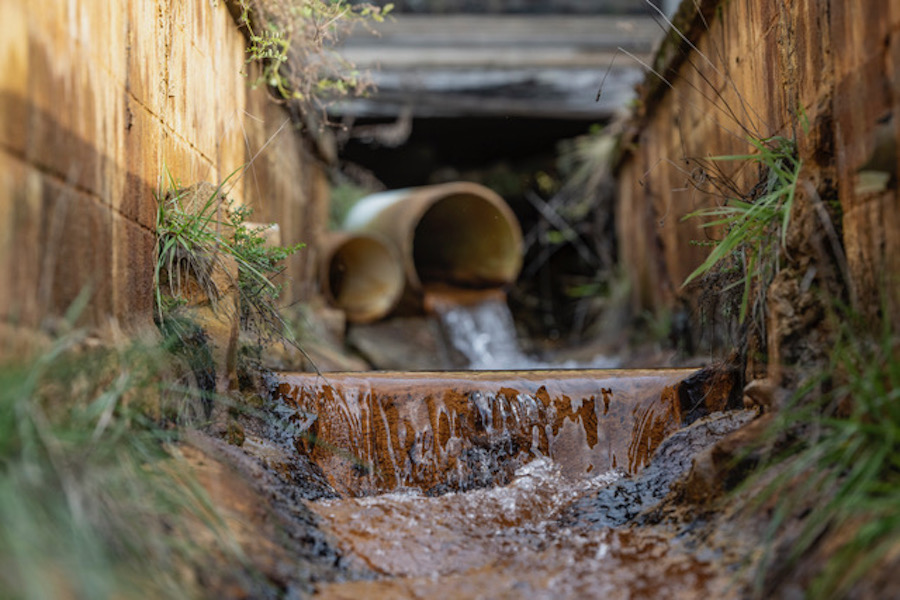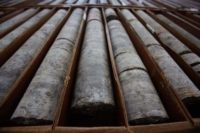DOE Pumps $466M for Critical Minerals, Renewables at Mine Sites

U.S. Energy Dept. funding will boost design of demonstration facilities in West Virginia and South Dakota to extract some critical minerals from acid mine drainage, as seen here at a West Virginia mine site.
WVU Photo/Brian Persinger
The U.S. Energy Dept. is pumping hundreds of millions of dollars into first-of-a-kind demonstration projects in two states to extract and process rare earth elements and critical minerals from coal and lignite mining waste at active and former mines, and also Into reuse of U.S. mine waste sites for clean energy projects.
The agency said April 4 it will invest $466 million from the 2021 federal infrastructure law into technology development—with $450 million earmarked over five years to support demonstration projects it said could repurpose 17,750 mine sites on 1.5-million acres across the U.S., and generate up to 90GW of clean energy.
Another $16 million will support front end engineering and design of production plants for the rare earths and critical minerals in West Virginia and North Dakota.
The funding supports U.S. intent to develop a domestic critical mineral supply chain, with more than 80% now imported, mostly from China.
It also is part of a larger investment to help fossil-fuel based energy communities shift to cleaner production. “Deploying clean energy projects on America’s mine lands will unlock new opportunities for energy communities," Energy Secretary Jennifer Granholm said in a statement, especially those in rural areas most affected by the energy transition.
Filling the Minerals Supply Gap
West Virginia University will gain $8 million to scale up a pilot plant that is extracting rare earths from acid mine drainage into a precommercial demonstration facility that can produce from 300 tons to 1,000 tons a year, Grant Bromhal, acting director for DOE’s Office of Fossil Energy and Carbon Management, Division of Minerals Sustainability, told ENR.
Rare earth elements and critical minerals from coal are used primarily in magnets for electric vehicles and wind turbines, Bromhal said.
The second phase of DOE funding will help develop design and construction of the plant, West Virginia Sen. Joe Manchin (D) said in a statement. About $5 million in earlier DOE funding helped develop the pilot plant, he said.
The agency has been steadily advancing technologies toward production and processing of rare earth elements and critical minerals in both the U.S. and allied countries since 2014, Bromhal said.
There are currently four pilots across the county to harvest rare earths and minerals from coal ash, waste coal and acid mine drainage. The agency wants more front-end design to advance pilot projects to completion by 2028.
It will cost $140 million to build one demonstration facility, Brad Crabtree, DOE assistant secretary for fossil energy and carbon management, says. More advanced design is intended to provide detail to attract additional investors.
Paul Ziemkiewicz, project leader and director of the West Virginia Water Research Institute at the university, says the group has selected several sites for the plant and is talking to stakeholders including environmental and economic development groups, trade unions and technology providers.
“We project that our demonstration facility will produce between 5.4% and 7.3% of the global requirements for terbium and dysprosium, two of the most sought after and critical rare earth elements,” he says.
Using acid mine drainage is set to provide at least 45% of desirable heavy rare earth elements most used in green energy and defense technologies, nearly four times that produced in traditional mines, Ziemkiewicz adds.
The University of North Dakota also will receive $8 million to develop design for a lignite extraction and processing facility in Grand Forks. Work will be conducted by faculty at the university's Institute of Energy Studies in its College of Engineering and Mines, with private sector technology partners. Researchers will use the university's drilling and completions lab, which can process about 500 kilograms per hour.
Following first-phase research, DOE will choose between the two awarded states for phase two, construction of the estimated $250-million rare earths processing facility.
Mine Sites Repurposed
“We can’t expand clean energy projects without more rare earth elements,” Crabtree said, noting the extraction technologies are linked to DOE’s plan to fund more clean energy projects on mine lands.
Clean energy project awards from DOE will be at least $10 million and no more than $150 million—making up a minimum of 50% of the cost of each project.
Eligible technologies include solar, microgrids, geothermal, direct air capture, advanced nuclear and energy storage. Also allowed are fossil-fueled electricity generation with carbon capture and sequestration.
Up to five clean energy projects will be deployed in geographically diverse areas with at least two solar projects.
The agency says examples include using vast expanses of flat mine area to generate solar power and also taking advantage of the spatial connection between development for clean heat or electricity.
Storing clean energy on existing pumped hydro storage sites also is an option, the agency says.
Concept papers are due May 11, and full applications by August 31, DOE says.




